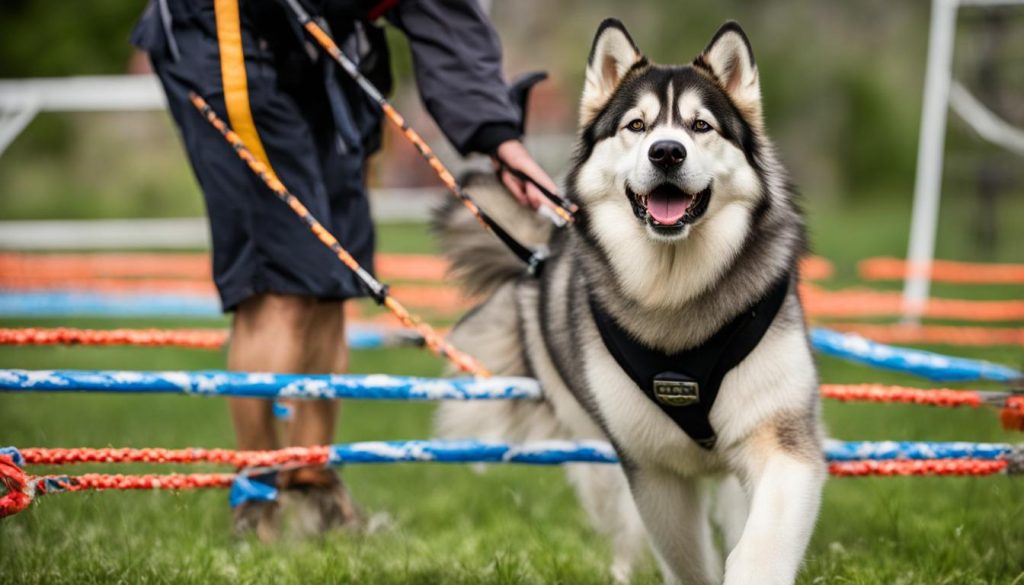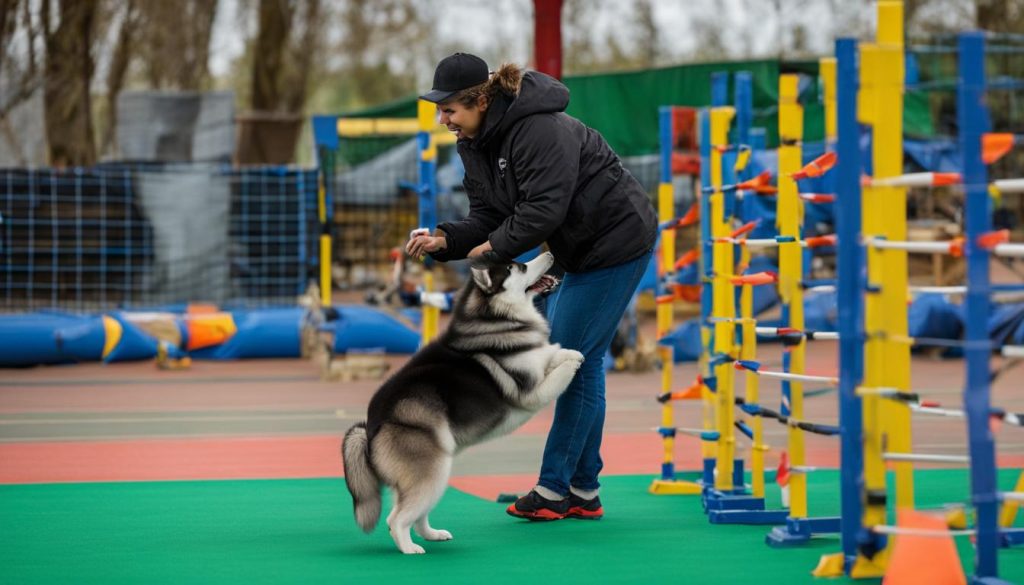Training an Alaskan Malamute can be a rewarding but challenging endeavor. These intelligent and independent dogs require a unique approach to training that takes into account their strengths and characteristics. In this article, I will share some valuable tips and techniques to help you succeed in your Alaskan Malamute training journey.
Alaskan Malamute Training
- Establish a strong foundation and bond with your Malamute before starting training.
- Consistency and positive reinforcement techniques are key to successful training.
- Consider enrolling in professional training classes or seeking the help of a dog trainer experienced with Alaskan Malamutes.
- Understanding the Alaskan Malamute mind and their unique characteristics is crucial for effective training.
- Positive reinforcement, consistent practice, and gradual increase in difficulty are effective training techniques.
Understanding the Alaskan Malamute Mind
When it comes to Alaskan Malamute training, it’s crucial to understand their unique characteristics. These intelligent and independent dogs often exhibit stubbornness, which can pose challenges during training. Additionally, Alaskan Malamutes have a strong pack mentality, emphasizing the importance of establishing yourself as the alpha in your dog’s eyes.
Starting training at a young age is key, as it allows you to shape your Malamute’s behavior early on. Socialization with people and other dogs is also crucial in ensuring your Malamute grows up to be well-adjusted and obedient.
To address common obedience and behavior issues specific to Alaskan Malamutes, enrolling in specialized training classes can be highly beneficial. These classes provide expert guidance and support in understanding and working with the unique traits of Alaskan Malamutes.

By investing time and effort into understanding the Alaskan Malamute mind and utilizing tailored training techniques, you can establish a strong foundation for obedience and behavior Alaskan Malamute training.
Effective Training Techniques for Alaskan Malamutes
When it comes to training an Alaskan Malamute, positive reinforcement is key. Using techniques that focus on rewards, such as treats, praise, and playtime, can motivate your Malamute to learn and respond to your commands. Consistency is equally important in their training journey, so make sure to use a distinct command word consistently and practice regularly.
Gradually increasing the difficulty of training sessions is crucial for your Malamute to learn to respond in different settings. Start in a controlled environment with no distractions and gradually introduce distance and distractions so your dog becomes accustomed to them. This will ensure that your Alaskan Malamute learns to obey your commands in any situation.
To make the training sessions more engaging for your Alaskan Malamute, use an enthusiastic, high-pitched voice and incorporate fun activities into the training routine. Making yourself interesting and rewarding to your Malamute will enhance their motivation to respond to your commands.
Avoid punishing your Alaskan Malamute for not immediately responding to commands. Instead, focus on patience and persistence. Remember that training takes time, and every dog learns at their own pace. Celebrate small victories and continue to reinforce positive behaviors.

With these effective training techniques for Alaskan Malamutes, you can develop and strengthen a strong bond with your furry friend while teaching them essential commands and behaviors. Patience, consistency, and positive reinforcement will pave the way for a well-trained and obedient Alaskan Malamute.
Tips for Alaskan Malamute Leash Training
Leash training is an essential part of training your Alaskan Malamute. It helps ensure their safety and control during walks and outings. Here are some tips to make the leash training process more effective and enjoyable for both you and your Malamute.
- Start in a controlled environment: Begin the leash training in a calm and distraction-free space, such as your backyard or a quiet park. This allows your Malamute to focus on learning without being overwhelmed.
- Use positive reinforcement: Positive reinforcement is a powerful training technique that involves rewarding desired behaviors. Whenever your Malamute walks calmly on the leash, reward them with treats, praise, or playtime. This reinforces their good behavior and encourages them to repeat it.
- Gradually increase difficulty: Once your Malamute is comfortable walking on the leash in a controlled environment, start introducing different environments and distractions. This helps them generalize their leash manners and prepares them for real-world situations.
- Be interesting and rewarding: Make yourself engaging and rewarding during leash training sessions. Use an enthusiastic tone of voice, initiate fun activities, and provide occasional treats or praise. This creates a positive association with leash training, making it a more enjoyable experience for your Malamute.
- Consider a long training leash: If your Malamute is still learning and needs extra control, using a long training leash can be beneficial. It gives them more freedom to explore while maintaining your ability to guide and redirect their behavior.
Remember, leash training takes time and patience. Every dog learns at their own pace, so be consistent, remain positive, and reward progress. With the right techniques and a strong pack leadership, you can help your Alaskan Malamute become a well-behaved and leash-friendly companion.
Conclusion
Training an Alaskan Malamute requires dedication, patience, and consistency. It is crucial to establish yourself as the alpha and build a strong bond with your Malamute to ensure successful training. By using effective training techniques such as positive reinforcement, consistent practice, and gradually increasing difficulty, you can help your Malamute learn obedience commands and behaviors.
Professional training programs and classes specifically designed for Alaskan Malamutes can provide valuable guidance and support. These programs offer expert knowledge and tailored approaches to address the unique training needs of your Malamute. Consider enrolling your Malamute in a professional training program to receive guidance from experienced trainers.
Remember that every dog is unique and may require different amounts of time to master training commands and behaviors. Be patient and persistent in your training efforts. Stay committed to a regular training schedule and practice the commands consistently. With the right training techniques, professional guidance, and plenty of practice, your Alaskan Malamute can become a well-trained and well-behaved companion.
FAQ
What are some tips for training an Alaskan Malamute?
Some tips for training an Alaskan Malamute include establishing a strong foundation and bond, using positive reinforcement techniques, being patient and persistent, and considering professional training classes.
How is the Alaskan Malamute’s mind different from other dogs?
The Alaskan Malamute’s mind is unique as they are intelligent, independent, and exhibit stubbornness. They also have a strong pack mentality, making it important to establish yourself as the alpha and provide consistent training.
What are effective training techniques for Alaskan Malamutes?
Effective training techniques for Alaskan Malamutes include positive reinforcement, consistent practice, gradually increasing difficulty, and seeking professional guidance if needed.
How can I leash train my Alaskan Malamute?
To leash train your Alaskan Malamute, start in a controlled environment, use positive reinforcement techniques, gradually increase difficulty and distractions, and consider using a long training leash for added control and safety.
What are some key factors to consider in professional Alaskan Malamute training?
Professional Alaskan Malamute training programs can provide valuable guidance and support. It is also important to establish a training schedule, use consistent training commands, and focus on effective training techniques.






